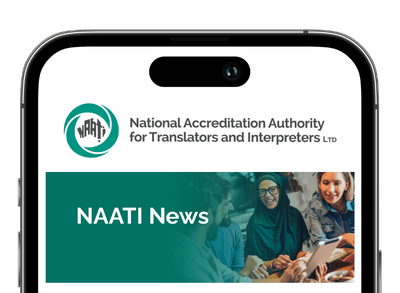Reminder for candidates
Preparing for test day
NAATI will send you the task brief for your test tasks three days before your test day. You should use these to prepare for your test. You will not have any additional preparation time on test day.
You may wish to bring food to the test venue as you may need to wait several hours for your test to start. Any food must be consumed in the Waiting Room.
You can bring a single printed A4 sheet containing the test task brief and your preparation notes for each task (i.e. three sheets of paper in total).
NAATI will provide:
- Task briefs for the dialogue tasks which will be emailed 3 days before the test
- An interpreting brief for the monologue task which will be emailed one week before the test
- A pen and paper for note taking (to be returned at the conclusion of each task)
- A glass of water.
NAATI will not provide:
- Internet access for candidates
- Other resources to prepare for the dialogue tasks.
You must follow these conditions. If you do not, NAATI may cancel your test or not issue your test result. If this happens, you will not receive a refund of your test fee.
Leaving the test venue
Once the test session has started, you are not allowed to leave the test venue until your test is complete. If you do, you cannot re-enter the venue or continue your test at a later time.
Behaviour on test day
You are expected to be courteous and respectful towards NAATI staff, supervisors and other candidates. You cannot communicate with other candidates on the test day once your test has started.
Use of internet and communications devices
You are not allowed to use any electronic devices. These devices include your phone, laptop, tablet, smartwatch and any other electronic devices. When you check in for the test, you will be asked to turn off all your electronic devices, put them in your bag and leave your bag in secure storage space.
You must not use any communication and recording functions of any devices for the duration of your test session.
Confidentiality
All test materials are the property of NAATI. You are not permitted to make or take away copies, paper or electronic, of any test material, or reproduce the test or communicate the test content to other candidates or a third party.
NAATI has developed test preparation modules to help you get ready for your test. These modules are available through NAATI Learn and anyone can access them for free.
They provide you with:
- Practice dialogues in Auslan and a practice monologue from English to Auslan
- A built-in audio recorder allows you to record and download your own performance
- Self-assessment tools, including a self-review sheet to allow you to critically assess your own performance.
To access the preparation module, click here. You don’t need to create an account. Just select the CPI Preparation Module from the dashboard.
These materials are © National Accreditation Authority for Translators and Interpreters Ltd (2022) and cannot be reproduced without the written permission of NAATI.
Test overview
The Certified Provisional Interpreter test assesses your ability to provide quality, professional interpreting of non-specialised dialogues and monologues commonly encountered in daily-life situations, using appropriate interpreting modes.
The Certified Provisional Interpreter test consists of the following three tasks:
- two Simultaneous Interpreting Face-to-Face Dialogue tasks, followed by
- one Simultaneous Interpreting Monologue into Auslan task.
Each task involves a different situation from a different domain.
The dialogue tasks are live role-plays. There will be two Role-Players involved in each dialogue task, one English-speaker and one Auslan signer.
The test usually takes around 1 hour per candidate from the time it starts.
You may need to wait several hours for your test to start after you check in, depending on the number of candidates that day. The expected completion time of the test session is listed in your test confirmation email.
You may wish to contact your local NAATI office in the week prior to your test to get a more accurate indication of the test day schedule.
After you check in, a NAATI staff member will direct you to sit in the Waiting Room. You will wait in this room until it is time to start your test. In the Waiting Room, you can only access your printed A4 sheets containing your task briefs and preparation notes. You cannot use any electronic devices in this room.
The only resources you can bring into this room are the interpreting brief and any handwritten notes you made when preparing for the tasks. For the dialogue tasks, your notes should be contained on one A4 page per test task.
You may take notes during the test. After the task, you must leave the interpreting brief and any handwritten notes in the Test Room.
NAATI staff are not permitted to talk about the content of the task or comment on your performance.
You must always follow NAATI’s instructions.
Sitting the test
NAATI will not admit you to the test if you arrive after the registration closing time.
The test will be video recorded for identity verification, assessment and auditing purposes.
You will primarily use the simultaneous mode to interpret two face-to-face dialogues between two role-players about the topic and situation described in your interpreting brief. The role-players are in the same room as you for these tasks. You may switch between simultaneous and consecutive mode during these tasks if needed.
For each task, the role-play dialogue begins as soon as you enter the Test Room. The Auslan-signing role-player will greet you and you will have a brief informal conversation (1-2 minutes). You can use this time to settle into the task and familiarise yourself with the role-player’s style of signing. After this brief conversation, the English-speaking role-player will join in.
You should introduce yourself to both role-players (in English and Auslan as appropriate) as ‘the interpreter’ or using only your first name. Do not use your full name. NAATI examiners will not assess this introductory part of the task.
The English-speaking role-player will begin the timed assessment part of the task by saying “ok, let’s start” or similar. You must interpret what the role-players say and sign from this point on. You should interact with the role-players to accurately transfer the meaning between them.
Each task will finish when the dialogue between the two role-players ends, or about 10 minutes after the start of the assessed part.
Role-Players
The age and gender of the role-players may not accurately represent the age and gender of the characters described in the brief. In some briefs, characters are given female and male names because their role is not gender specific. You should refer to the role-player by the name with which they introduce themselves.
Under the test situation, the candidate should not ask the role-players to speak or sign in short sentences or segments for the entire dialogue. The role-players will not be able to accommodate the candidate with regards to such a request.
Managing Interaction
As the interpreter, you should listen and watch what the role-players say/sign and transfer the meaning accurately. You are also expected to demonstrate your ability to manage the interaction with the role-players to make sure you accurately transfer the meaning.
There may be instances, during the test, which make it challenging for you to capture and comprehend what has been said or signed, for example:
- the English-speaking role-player mumbles, speaks too softly, speaks while the other role-player is signing, or uses a word/phrase you do not know.
- the Auslan-signing role-player finger spells too quickly or not very clearly, turns away from you or uses a sign you do not know.
- there is a distracting noise or other interference.
You should use a range of strategies to deal with these instances, including:
- asking the role-player to repeat or clarify what they have said or signed
- asking the role-player to pause or slow down
- asking the role-player to speak more loudly or softly
- switch briefly to the consecutive mode if needed
- inserting a correction if you realise you have made an error
- using other strategies to manage the interaction and transfer meaning.
The use of these techniques is considered acceptable if:
- they result in accurate transfer of meaning.
- you are courteous.
- you inform the other role-players about what occurred in the other language.
- the flow of the conversation is NOT hindered.
You will use the simultaneous mode to interpret a monologue of about 3 minutes into Auslan. The monologue is played from a video recording for you by a test supervisor.
One week prior to the test, you will receive the interpreting brief for this task so that you can prepare. On the day of your test, you will not have any preparation time for this task.
In the Test Room, you can choose whether to stand or sit during the task.
At the start of the recording, the interpreting brief will be played to you. The monologue that you need to interpret will begin immediately after the interpreting brief. You should start interpreting as soon as possible after the monologue begins and continue to interpret for the duration of the monologue. You cannot ask for any clarifications, repeats or pauses of the recording.
The task will finish when you complete the interpreting, or about 4 minutes after the start of the source monologue video.
Assessment & results
Assessment
At least 2 NAATI examiners will independently assess your performance in the test. They will assess each task separately, using assessment rubrics with 5 bands (with Band 1 representing the highest level of performance and Band 5 the lowest). Your task performance will be marked against each criterion, which are the same for all task types, as outlined below.
For the Simultaneous Interpreting (Face-to-face Dialogue) tasks, NAATI examiners will assess your:
- Transfer competency: Meaning transfer skill, Interactional management skill, and Rhetorical skill.
- Language competency: Language proficiency enabling meaning transfer into the target language.
For the Simultaneous Interpreting (Monologue) task, NAATI examiners will assess your:
- Transfer competency: Meaning transfer skill, Application of interpreting mode, and Rhetorical skill.
- Language competency: Language proficiency enabling meaning transfer (into Auslan).
Refer to our language policy to understand how the examiners will assess your use of language in your test.
You need to achieve at least Band 2 for each criterion, and you must pass all six tasks to pass the test.
Results & receiving your credential
NAATI aims to issue results within 8-10 weeks of the test date. We will issue results as they are finalised, so some candidates will receive their results earlier than others even if they sit the test on the same day.
If you have already passed any prerequisite screening tests (Ethical Competency and/or Intercultural Competency), we will issue your credential if you pass this test.
Supplementary testing
You must attempt all three tasks and pass two of them to be eligible to apply for a supplementary test. You must apply for the supplementary test from your myNAATI account within 30 days of receiving your test results. The supplementary test will involve re-sitting only the failed task, but on a different topic.
If you pass the supplementary test, NAATI will award you the Certified Provisional Auslan Interpreter credential. If you pass the supplementary test, NAATI will award you the Certified Provisional Auslan Interpreter credential. If you fail the supplementary test, this means you have failed the test. You can apply for another Certified Provisional Auslan Interpreter test with NAATI if you want to sit the test again.




